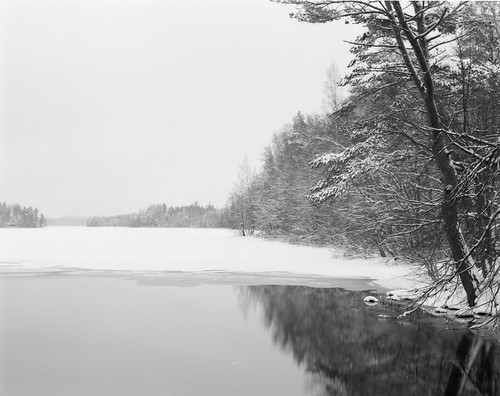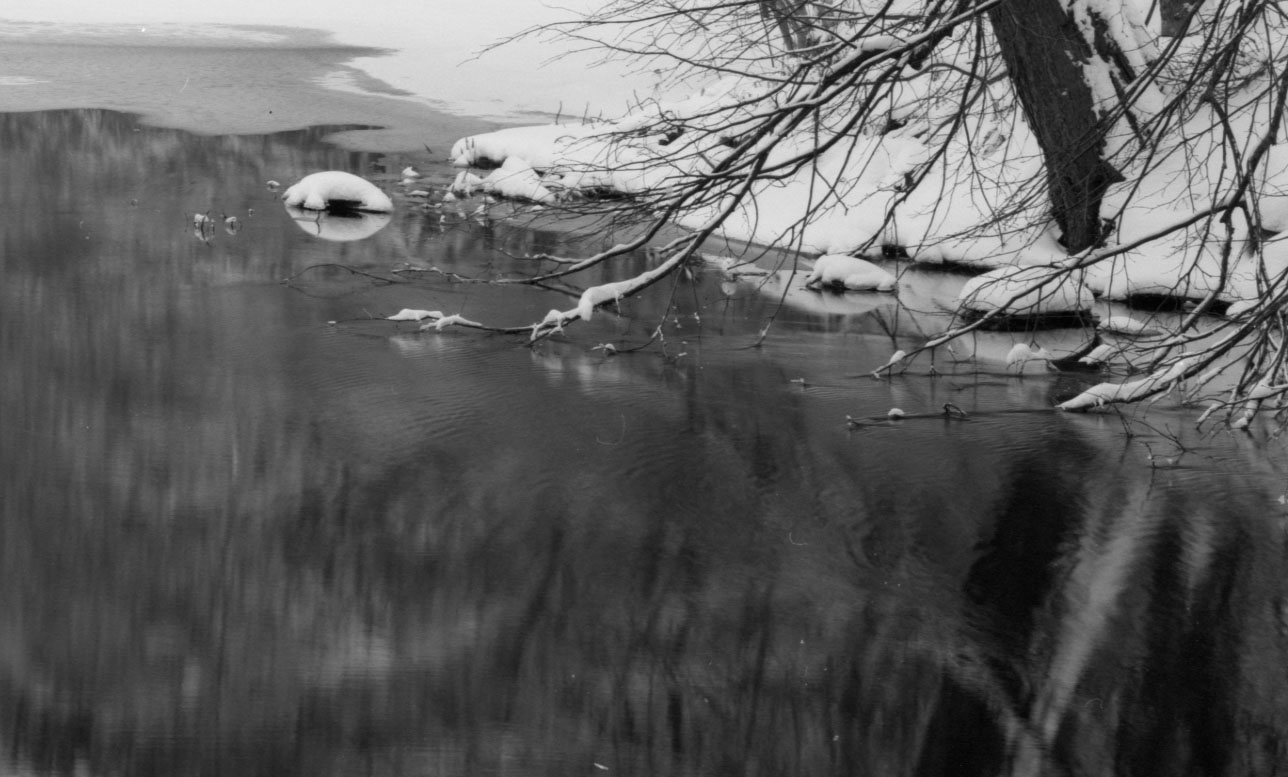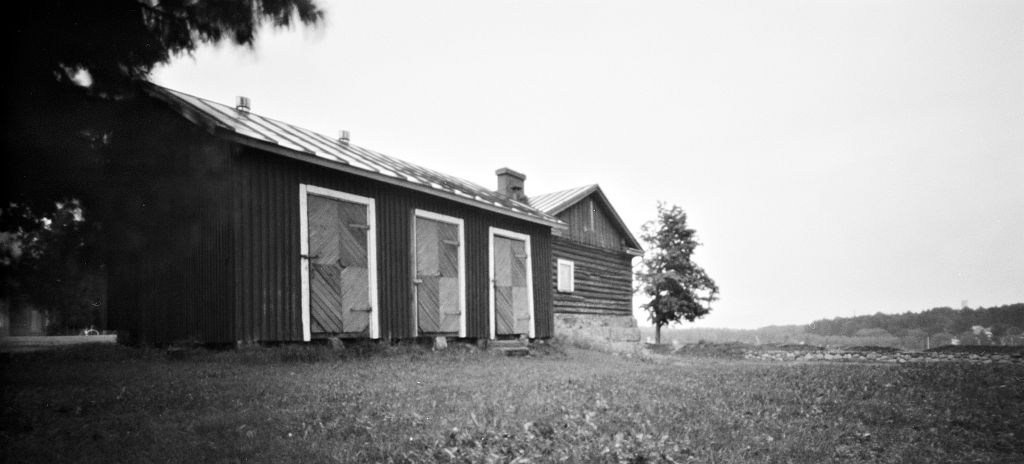One of the things which many photographers do is buy gear. There are often many reasons for buying gear, such as wanting something new or hoping to get better images. Often its a lust for the expensive , exotic or unattainable.
Strangely few seem to consider themselves as a key component in making the image. Its like the classic insult of telling a woman she has a good oven because her baking is good.
The image here is taken with my Toho 4x5 camera one still and cold winter day in Finland. Click it to load a larger preview (or 'middle button' click it should load that into a new window. There is nothing magical or high tech about the Toho, its it's just a box to hold the (sheet 4x5) film. The lens is a simple 180mm standard lens. Nothing exotic, no super fast aperture.
The image happily supports a scan of 3000dpi or 15,000 x 12,000 pixels or about 180Megapixels. To be honest I don't think that any digital camera at any price will make a significantly superior image. I'll plop below a segment (lower left) of scan taken some time ago with my Epson 3200 scanner at 1200dpi. That scanner is not 'top shelf' and issues like focus prevent it getting the full detail out of the image.
Back when I took this shot (oh, around 2009) there just wasn't anything around at all in the digital realm which would do better, perhaps there still isn't. Something like this will cost you less than 1/3 the cost of a full frame DSLR body.
Pursuit of IQ
Something which people often forget (and is part of the reason why I don't have 'big gun digital') is that if you want high resolution images you have to work for it.While its possible that the top shelf full frame DSLR cameras will go really close to this film image (and at what cost), to get such an image you'll need to dedicate yourself to using a good solid tripod be sure to focus critically and have a really top shelf lens. (Yet the lens I took that shot with cost about US$200 which is one of the advantages in having a bigger capture area).
My point here is to remind people that if you want to get high resolution images then just buying the right gear is not enough. Sony a7 alone is not going to do it, you'll have to work for it yourself too.
More years ago than I would like to admit to I read this book on high resolution image making, I still recommend it. Sure, some of the parts about film development are no longer relevant, but the aspects of camera and lens still are. If you are interested in learning about making your images clear and sharp then that's a good book IMO.
For myself if I'm going to struggle around with a tripod then putting a camera up and carefully focusing it (remember it has to be focused well too) then it just seems like a let down if all I do is click and then have to pull it all down again. Its kind of like going to all the trouble to court a lovely lady, take her out to dinner and then fall asleep after a quick hump.
Opportunity not missed
Now I don't always want to drag along a tripod for every image, and so it is for this reason that I love having appropriate cameras for the job.Micro4/3 for instance is great as its light, its compact, has more than sufficient resolution and has interchangable lens capability.
Image resolution is not top shelf but if I'm hand holding the camera then its likely I'm not going to get a 24Megapixel image (even if I have a 24 megapixel sensor and a lens which can deliver that result too).
For sure the micro4/3 camera will not give you the same IQ results as a Sony a7 or a Canon or Nikon full frame camera at maximum enlargements, but if you're hand holding maybe its true that you won't get the difference either.
Not to mention that focus accuracy may actually make the DSLR image of lower quality (see back focus / front focus which drove me nuts with my DSLR cameras). Ironically enough I went to Micro4/3 because I wanted to get sharper images (because out of focus is not sharp). So why carry around a lump of a camera and a triod when you're not going to take the time anyway?

True flexibility predates "systems"
Which leads me to lenses. One of the really nice features of micro4/3 (well and the NEX cameras which also have short focal flange distance) is that you can get some great lenses for not much money which can give you the opportunity learn. This is because not only can you take advantage of what your maker provides, but what almost every other maker provides. Systems are intended to lock you in to their stable.Sure, you may not need many lenses, you can go get a 12-40mm zoom and then a 45-200 zoom and have the whole range covered, but will you actually get:
- shallow DoF with those?
- better Bokeh?
- better value for money?
- better photographs?
- learn about photographic vision?
For instance I love experimenting with lenses to get a look I like, I also like to be in control. So naturally I like manual focus lenses. Last weekend I was at the funeral for my wifes grandmother (rest her soul) and of the many good images I took, I took this image with my GH1 and the Pentax 110 70mm f2.8 lens.
The background is rendered a little out of focus which gives it nice concentration on the subject. If I had used a modern zoom it would probably have been f5.6 and the background would have been much sharper and more distracting.
Of course I could have spend nearly a thousand dollars on a new Oly 75mm f1.8, but would it have been any sharper? One can see that its actually quite sharp (again, click for larger).
Not bad for an old $50 lens hand held.
My point here is that for people who actually want to make images that acquiring the gear (yes I have GAS) should be guided by selecting something beneficial and something which will actually help you along on your journey of making images (and learning about photography). Unless you collect gear for the sake of collecting gear (not a bad hobby by the way), understanding the why and how will guide you into developing an eye into what you buy.
Having said that, equally just picking up a an outlandish bargain can prove educational in just playing with something fun.
Good images are ones you like, its important to see that and important to learn about what the tools do to enable you to make that photographic vision leap out. Its not about "full frame" (unless you have a specific reason) or about adding more megapixels or having a "all in one zoom". Its about getting images that make you happy and develop your photographic spirit.
The wonderful things about right now in photography is there are oodles of choices in gear available without spending a fortune and dabbling and learning will enrich your life for not a lot of money.
Some food for thought
Pentax 110 50mm f2.8 lens on GF1
Holga plastic pinhole camera 120 Roll film
12mm Computar f1.3 TV lens on G1
90mm Fujinon on 6x12 roll film
So go out and have fun with your camera! (don't just sit around looking at camera gear)





















2 comments:
> So go out and have fun with your camera!
Very good advice. I like your top view camera image!
When it's all said and done, a good image would be the reward that all the expenses of gear is at least partially justified :)
Some very fine images in this piece. It's not what gear you use; it how much fun and joy you can have from using it.
Post a Comment